Over the years, I’ve done quite a bit of coverage about lawn issues, as I really do believe that the lawn can be one of the primary sites of transformation and change for ordinary Americans and others in the Western industrialized world. Not only can the lawn be transformed from a consumptive space to a productive one for growing vegetables, herbs, and flowers to benefit humans and other life, but it can be a site of personal reconnection and healing with our landscape.
This is because the lawn is the single piece of nature that the bulk of people, living outside of big cities, encounter on a daily or weekly basis. If we can transform the lawn, we can transform ourselves.
This is why I am so excited about this post–through the example of Nature’s Harvest Urban Permaculture Farm, a new creation of my dear friend, Linda Jackson, I will provide an introduction to how to convert a front yard to a vegetable garden using permaculture design principles. This is Linda’s story, but she’s asked me to report on it for you here to get the word out. I’ll also say that I’m only telling part of the story now–I’ll provide more updates later in the year and talk about what she planted and how its all doing–and more responses from the community.
Impetus for Change
Linda was a certified organic farmer, a farmer’s market board member, a board member of a state-level organic farming rganization, and a horticulture teacher for many years. Last summer, through some trying life circumstances, she was displaced from her farm and ended up in a small home in a suburban area in a town called Lake Orion (in South-East Michigan). Linda moved from 10 acres to a tiny 100×200′ plot (with a 50′ x 50′ growing area in the front yard; back yard is full shade). Linda used her background in farming and permaculture design to convert her plain, everyday lawn into not only a place to grow some great vegetables, but also a place of community change and empowerment. Here’s how she did it.

Getting Legal
Before one begins to convert one’s yard, the legal aspects must be considered and weighed. As my own run ins with township ordinances have attested, and as protections of small urban farms have been removed in Michigan in the last 12 months (and the legal battles everywhere raging about front-yard farming), Linda decided to take no chances with her plan. She went directly to the township supervisor and spoke with him about her design and plan for her front yard. He told her that as long as she wasn’t growing “weeds” it wasn’t a problem. She also read through the township ordinances thoroughly to learn what could and couldn’t be done. We are still crossing our fingers that, now that she’s gotten the garden installed, that this will hold true. But so far, so good!
For those of you thinking about converting your own yards–do keep legal ordinances (and homeowner’s associations) in mind. They can really sink (and fine, and bulldoze) your hard-earned efforts. And even a statement like “don’t grow weeds” is tricky–my township, for example, designates common milkweed as a noxious weed (when its a beneficial native plant).
Goals for the Urban Permaculture Farm
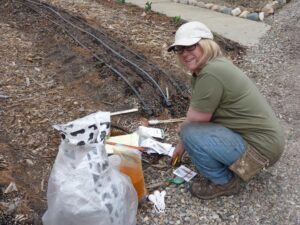
Before Linda designed her farm and set into action, she created a list of goals to help guide her efforts. She knew farming her front yard in the urban setting was going to be quite different than farming her quiet ten acres in the country. Given this, her goals were as follows:
- Do away with mowing, herbicides, pesticides, traditional lawn maintenance
- Build a balanced farm ecosystem using permaculture design
- Grow quick annuals and perennial fruits, herbs, flowers
- Allow farm to turn a profit by selling produce and farm goods a farmer’s market every two weeks
- Grow biointensively and organically; use small space gardening and vertical gardening to maximize yield
- Use my plot as an educational site for community
- Generate curiosity and excitement in the community
- Create an aesthetically pleasing, unique space
Her triple bottom line was: ecological, social and economic sustainability.
Design and Observations
Linda examined her specific site over a period of weeks (she could have waited and observed longer as permaculture design principles suggest, but winter was coming fast and she wanted to get her hands in the soil and start growing first thing in the spring). So waiting a year wasn’t an option!

During these observations, she created a plan of action. In observing her site, she paid attention to the light (recognizing the need to take out several trees); the rainfall (including where water pooled and where it was dry) and the slope of the land and elevation changes. She also noted the microclimates near her house, where the sun reflected from the house siding and onto the soil, keeping it dryer and warmer than other areas.
Preparing the Site

Two ornamental fruit trees (that did not produce fruit) and a silver maple were first removed to produce full sun on the site. These produced 15 yards of chipped mulch, which Linda put to good use as pathways in her garden. After the trees were removed, Linda also ordered 10 yards of compost from a local compost company and set to work (and she worked full days, 4-5 days a week, for 5 weeks to finish her site).
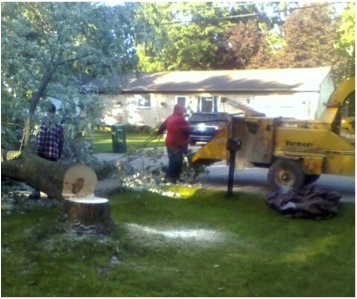
Linda knew she wanted her farm to be aesthetically pleasing and mimic patterns in nature (another permaculture design principle). To do this, she used a hose and the natural contour of the land and laid out her beds and pathways. She had the idea of “flow” in her mind as she designed, creating a series of soft waves.

After this, Linda laid down brown recycled paper to create a weed barrier (similar to the sheet mulch techniques I shared several years ago on this blog). Then she laid down her thick mulchled pathways (about 6″ of mulch) and added more weed barrier compost for the beds themselves (eventually making it to 10″ after a neighbor blew leaves all over her farm and she laid down a second layer!). Here are some photos of the transformation as it took place.

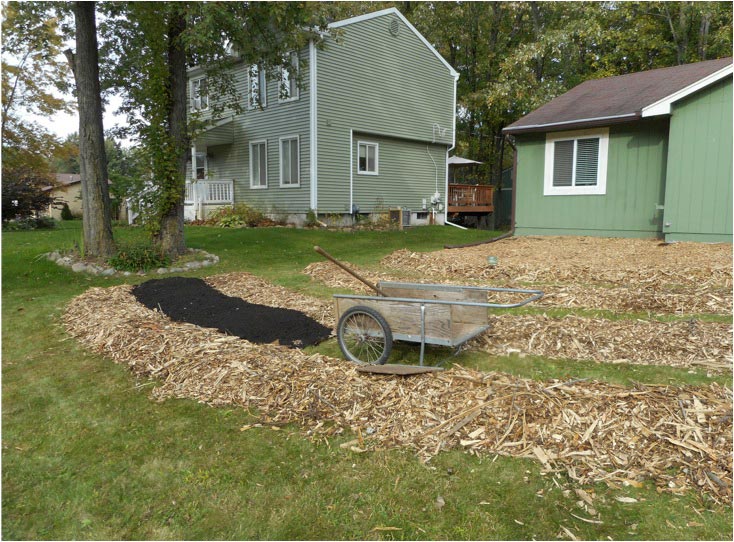



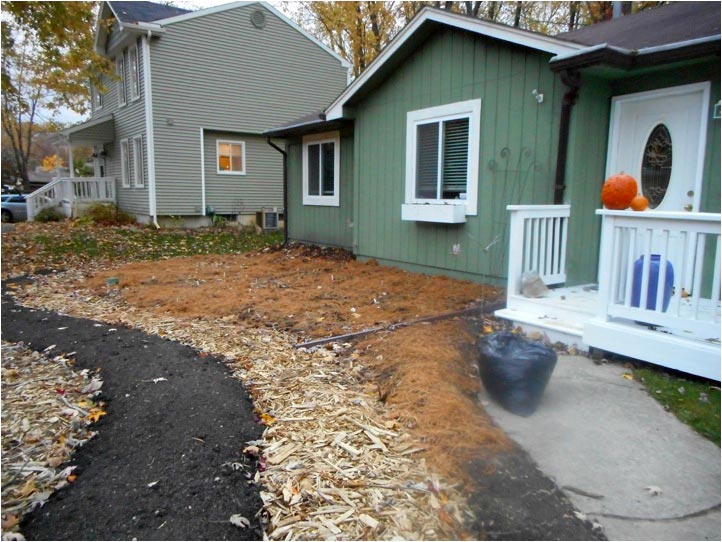

Spring Planting
After the snow melted and the temperatures warmed up this spring, Linda installed drip irrigation lines and began her finishing touches on the garden and the soil composition before planting. I visited her this past week, and together, we planted kale, radishes, and chard: the first of the spring crops able to go into the ground. Linda impressed me with her organic pest control techniques: each kale seedling got a healthy spoonful of cayenne pepper and each chard seedling was popped into a toilet paper tube to protect it from rodents, slugs, and possible frost damage (and this was a good thing, since its really chilled down recently). Here are some shots of the current garden. I was also impressed that we planted nearly 80 kale seedlings in her space, with plenty of room for many other delights! I think she’ll have no problem having plenty of product to take to the farmer’s market and to put on her plate.



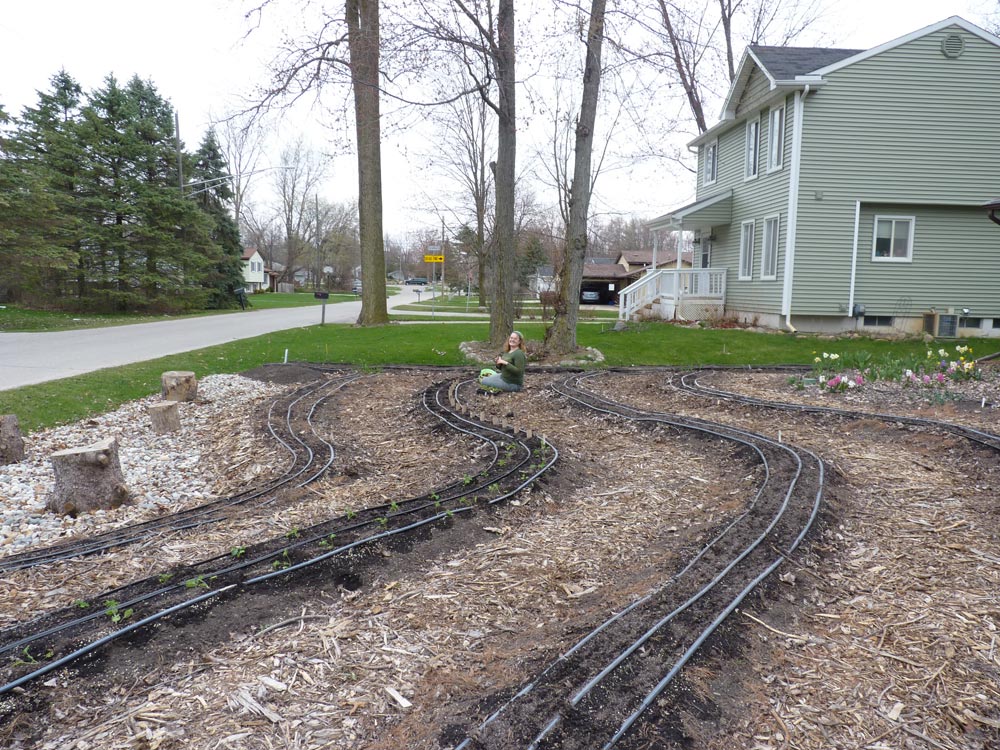
Promoting a Positive Image in the Community
As Linda put her garden in in the fall and as the weeks passed, the neighbors watched the yard’s transformation and anticipation in the community grew substantially. Here was someone doing something unique, different, groundbreaking, and exciting. The important thing to understand about this kind of public growing space is that people will talk. They will ask questions, they will be curious, and interest (of several kinds) can take place. I experienced this firsthand when we were planting kale, chard, and radishes this past week. Multiple people stopped by, took a look, asked what we were up to. We cheerfully told them and they smiled and said they were thinking about doing it themselves. So far, Linda has been lucky as the response in her community has been incredibly positive. Several people have asked her to put in gardens for them–but Linda wants to empower them to do their own work, not do it for them.

Given the above, Linda decided to be proactive about promoting her space, and in addition to talking to the township prior to starting, she decided to create some marketing materials. She went to my friends at Roots to Fruits for some snazzy graphics to share and feedback on her designs. I also helped her create a Powerpoint presentation that she shared in over the winter at a few local and regional events. I also worked with her to create a brochure that she can give to people who are passing by that explains both the purpose of the garden and resources to get started. The brochure will be housed in a “take one” box on her mailbox so anyone who comes by can learn more about the site. I’m including the brochure in jpg format here as well (you can click on it to see it full size).

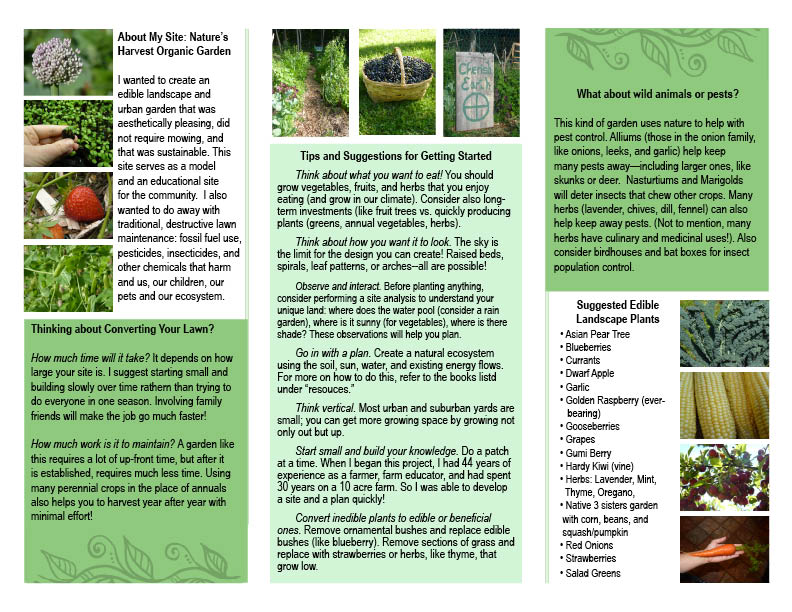
I think the proactive approach to marketing and community engagement is really the key to a successful front-yard garden, especially one that will stand the test of time. As I mentioned at the start of this post, I’ll be checking in with Linda later in the summer on a visit back to Michigan to see how things are going!
Conclusion
In many ways, the typical lawn is a reflection of our own strained relationship with nature. Its poisoned and modified (as is much of the food we eat), it is unsustainable (as much of our lifestyles are), it has an appetite for chemicals and fossil fuels (as many of us do), and its generally barren with little activity or diversity of life (as nightly TV addictions can attest). Transform the lawn, and in the process, we can transform ourselves, our communities, our world.
I’ve seen this transformation in my friend Linda, who left a very difficult situation scarred and wounded. Through installing this front-yard farm, Linda was transformed and healed. And now this lawn, transformed, is transforming the community. Linda tells me of two neighbors on her street that are considering converting their front-yards to veggies and fruits as well, and I suspect that many more will follow the trend in the years to come. Since she’ll be selling veggies at the farmer’s market, she will inspire so many more who might not walk or drive down her street with her story, and most importantly, her delightful edible goodies.


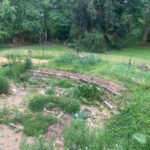

This is just awesome. I feel like this is a missing link between farming and communities. A big, productive garden where people can see it will be the best advertisement and motivator for people to know that they can do it too. Question–are the planting beds all compost? She simply put compost on top of the old lawn?
Yep, she basically laid down the recycled paper as a weed suppressant and then compost. She’s growing in compost, with all of the neighborhood fall leaves added in (so its kind of a sheet mulch). I’m guessing next year she’ll use a broadfork to work in the underlying soil after all the grass is dead–that’s what I did with a lot of my beds too, and it works really well. Start with sheet mulching or straight compost, then the following year, double dig them…. We also have highly alkali soil here (above 8.0 in many places), so adding lots of compost brings the soil PH down to something better for the plants as well.
Reblogged this on Laura Bruno's Blog and commented:
In case it’s not obvious: I completely agree with everything shared in this post. Transform our lawns, transform ourselves, transform our communities. I experience this daily, as I’m out front, meeting neighbors walking their dogs, talking with the next door neighbors as I plant, mulch or weed, having micro-visits with David’s dad as he stops by on his errand runs.
Front yard gardens definitely start conversations, and yes, they are contagious. I know more and more people planting fruit trees and tearing up their lawns. OK, so maybe I called a bunch of people when I saw non-GMO fruit trees on sale at Tractor Supply Co. Maybe I emailed our Transition Goshen team. In any case, a little bit of encouragement and some bold plantings do change everything, season by season.
This post gives excellent advice about getting started on transforming your own yard from a resource sink to a productive source of joy and beauty. Happy planting!
LOLOL, I love the “contagious” nature of front-yard gardens :). They are contagious! I love that–and will share that with Linda.
Thanks! Linda’s story was very inspiring, too — both the personal transformation in her and the way what she’s doing will undoubtedly make others realize what’s possible. It’s one thing to farm large acreage. Quite another to consider having a farmer’s market booth from a front yard. Thanks to both of you for sharing her story!
LOL, I am so excited to see how many veggies she manages to get out of the front yard for sale. She is doing biointensive planting and vertical gardening, so I suspect she’ll do quite well going every two weeks! And those 80 kale plants we planted will help 😛
“In many ways, the typical lawn is a reflection of our own strained relationship with nature. Its poisoned and modified (as is much of the food we eat), it is unsustainable (as much of our lifestyles are), it has an appetite for chemicals and fossil fuels (as many of us do), and its generally barren with little activity or diversity of life (as nightly TV addictions can attest). Transform the lawn, and in the process, we can transform ourselves, our communities, our world.”
So nicely said! Thanks for sharing this project. It is exciting to see more examples of permaculture gardening in suburbs and cities!
Thank you so much! I hope to keep bringing more great examples…and, given my life transition into renting in a city, I might even tackle permaculture for the apartment renter in the future 😛
The garden plan notes a hugelkulture mound, but the process didn’t describe one being put in. Is it there, or is it a future plan perhaps?
Sorry! I forgot to mention the hugel mound. Its on the edge on the left. She used yard waste from other’s yards in doing so, plus some tree waste (like fallen branches, etc). It is going to be the site of some low-growing berry bushes! I’ll talk more about it in the next update 🙂
Reblogged this on inanna alive.
Thank you! 🙂
[…] This post gives excellent advice about getting started on transforming your own yard from a resource sink to a productive source of joy and beauty. Happy planting! Originally posted on The Druid’s Garden: […]
Yes, thank you for the reminder on how healing garden spaces can be for people. Reminds me, that I have this potentially flourishing ground space. I’m going to get out their with my kin and do me some more planting. Just to have my hands in the Earth if nothing else.
Yeah, sounds like a great plan! I am really going to miss my garden this year….will have to find others’ gardens to work in!
I just need to find the time. Determined to get some gardening time in over the holidays!
Recently discovered your blog and really fascinated by it. Please continue the good work of sharing this vital information. Where I live at the moment I don’t have the option to do something like this but when I settle down in my own home in a few years I will be looking to design a very sustainable garden/farm lifestyle in and around the home. Thanks!
American Druid – thanks for the comment :). I am actually taking a new job and leaving my homestead, so in the upcoming year or so, expect some posts about sustainable and spiritual practices you can engage in while renting 🙂
This is such an awesomely put together idea and executed so well. I have been working on creating an urban farm on my .25 acre peice of urban property for the last few years, but I have yet to do it on this scale. At the moment we have established strawberry, blueberry, raspberry, apple, grapes, and various vegetables in our 3 raised beds. My front yard is still grass. I am definitely going to look into this.
I will have to make a post of my progess so far.
I would LOVE to hear of your progress! And great job on getting those perennials in the ground first–that’s a great start and perennial crops are really the way to go, long term. Would love to hear more!
Reblogged this on The Food Reality Blog and commented:
Perma-culture is a fancy way of saying , “reclaim your money and put it (and your time) to use making food to sustain your life”. In other words…. Here is the door to getting yourself out of the income-debt merry-go-round.
It’s a good thing to check into…. If just to read about. Just like any real relationship, it’s best to get to know everything you can before committing yourself.
My journey began about 12 years ago when I started reading,… About 6 years ago when I took off to Oregon to live on some farms and off grid for two years, and 3 years ago when I decided what’s best for me is to bring in around 5 new pants each spring, and get to know them intimately…. Working tinctures out, storing, processing techniques.
For me, it’s all about creating from nature what I know corporations create with chemicals….
I’m a nature girl … Through and through.
Check out this article… I hope you love it too!
Yay! Thanks for the reblog :). I love your statement “creating from nature what I know corporations create with chemicals!” That’s it exactly!
[…] Lawns to Gardens: Nature’s Harvest Permaculture Urban Farm on The Druid’s Garden at druidgarden.wordp… […]
[…] Converting Lawns to Gardens: Nature’s Harvest Permaculture Urban Farm on The Druid’s Garden at druidgarden.wordp… […]
[…] Gazons omzetten in tuinen: Nature’s Harvest Permaculture Urban Farm on The Druid’s Garden at druidgarden.wordp … […]
Beautiful job! I’m not joking the last picture made me almost tear up. This is exactly what I’ve been searching for! So excited for this
[…] Slika s naslovnice: Nature’s Harvest Permaculture Urban Farm @ The Druids Garden […]
[…] Mala permakulturna urbana farma (The Druids Garden) […]
Beautiful, thanks for sharing this.
I offer some tips and resources for those attempting to provide habitat for wild beings, nectar for pollinators as well as food and medicine for humans while staying under the radar in areas with really aggressive monoculture HOA rules or Orwellian municipal laws in this article:
https://gavinmounsey.substack.com/p/covert-food-gardening-in-the-era?